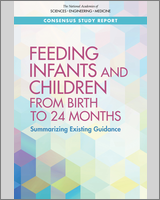NCBI Bookshelf. A service of the National Library of Medicine, National Institutes of Health.
Recommendations for feeding infants and young children have changed substantially over time owing to scientific advances, cultural influences, societal trends, and other factors. At the same time, stronger approaches to reviewing and synthesizing scientific evidence have evolved, such that there are now established protocols for developing evidence-based health recommendations. However, not all authoritative bodies have used such approaches for developing infant feeding guidance, and for many feeding questions there is little or no sound evidence available to guide best practices, despite the fact that research on infant and young child feeding has expanded in recent decades. Summarizing the current landscape of feeding recommendations for infants and young children can reveal the level of consistency of existing guidance, shed light on the types of evidence that underpin each recommendation, and provide insight into the feasibility of harmonizing guidelines. Feeding Infants and Children from Birth to 24 Months collects, compares, and summarizes existing recommendations on what and how to feed infants and young children from birth to 24 months of age. This report makes recommendations to stakeholders on strategies for communicating and disseminating feeding recommendations.
Contents
- The National Academies of SCIENCES • ENGINEERING • MEDICINE
- COMMITTEE ON SCOPING EXISTING GUIDELINES FOR FEEDING RECOMMENDATIONS FOR INFANTS AND YOUNG CHILDREN UNDER AGE 2
- Reviewers
- Summary
- 1. Introduction
- 2. Methodology
- 3. Characteristics of Included Guideline Documents
- TYPES OF GUIDELINE DOCUMENTS
- LEVEL OF COLLABORATION
- SCOPE OF TOPICS COVERED
- TARGET COUNTRY OR REGION
- TARGET AUDIENCES
- GUIDELINE DOCUMENT METHODOLOGIES
- DECLARATION OF CONFLICTS OF INTEREST
- STATEMENTS OF RECOMMENDATION
- EVIDENCE MAPPING TO EACH RECOMMENDATION
- INCLUSION OF GUIDANCE ON COMMUNICATION AND DISSEMINATION
- INCLUSION OF RESEARCH RECOMMENDATIONS
- SUMMARY
- 4. Existing Recommendations on What to Feed
- EXCLUSIVE BREASTFEEDING
- CONTINUATION OF BREASTFEEDING
- SUPPLEMENTARY FORMULA FEEDING OF BREASTFED INFANTS
- DURATION OF INFANT FORMULA USE
- TYPE OF INFANT FORMULA
- TODDLER MILKS AND FOLLOW-ON FORMULAS
- MILK AND MILK-BASED PRODUCTS
- FLUIDS: WATER, JUICE, SUGAR-SWEETENED BEVERAGES, AND OTHER NONMILK BEVERAGES
- SUBSTANCES TO AVOID OR LIMIT
- VARIETY AND HEALTHY, NUTRITIOUS FOODS
- FRUITS AND VEGETABLES
- VEGETARIAN AND VEGAN DIETS
- FOODS ASSOCIATED WITH FOOD ALLERGY AND CELIAC DISEASE
- IRON
- VITAMIN D
- IODINE
- OTHER NUTRIENT SUPPLEMENTS
- DIETARY FAT
- SUMMARY
- 5. Existing Recommendations on How to Feed
- 6. Communication and Dissemination
- 7. Conclusions and Future Directions
- References
- Appendix A. Excluded Guideline Documents
- Appendix B. Abstracted Recommendations
- Appendix C. Committee Member Biographical Sketches
Suggested citation:
National Academies of Sciences, Engineering, and Medicine. 2020. Feeding infants and children from birth to 24 months: Summarizing existing guidance. Washington, DC: The National Academies Press. doi: https://doi.org/10.17226/25747.
Digital Object Identifier: https://doi.org/10.17226/25747
Library of Congress Control Number: 2020941774
Additional copies of this publication are available from the National Academies Press, 500 Fifth Street, NW, Keck 360, Washington, DC 20001; (800) 624-6242 or (202) 334-3313; http://www.nap.edu.
Printed in the United States of America
- NLM CatalogRelated NLM Catalog Entries
- Responsive Feeding Recommendations: Harmonizing Integration into Dietary Guidelines for Infants and Young Children.[Curr Dev Nutr. 2021]Responsive Feeding Recommendations: Harmonizing Integration into Dietary Guidelines for Infants and Young Children.Pérez-Escamilla R, Jimenez EY, Dewey KG. Curr Dev Nutr. 2021 Jun; 5(6):nzab076. Epub 2021 Apr 30.
- Association between pacifier use and breast-feeding, sudden infant death syndrome, infection and dental malocclusion.[Int J Evid Based Healthc. 2005]Association between pacifier use and breast-feeding, sudden infant death syndrome, infection and dental malocclusion.Callaghan A, Kendall G, Lock C, Mahony A, Payne J, Verrier L. Int J Evid Based Healthc. 2005 Jul; 3(6):147-67.
- Infant and young child feeding practices among African pastoralists: the Datoga of Tanzania.[J Biosoc Sci. 1998]Infant and young child feeding practices among African pastoralists: the Datoga of Tanzania.Sellen DW. J Biosoc Sci. 1998 Oct; 30(4):481-99.
- Review Human milk and breast feeding: an update on the state of the art.[Pediatr Res. 1982]Review Human milk and breast feeding: an update on the state of the art.Ogra PL, Greene HL. Pediatr Res. 1982 Apr; 16(4 Pt 1):266-71.
- Review [WHO growth standards for infants and young children].[Arch Pediatr. 2009]Review [WHO growth standards for infants and young children].de Onis M, Garza C, Onyango AW, Rolland-Cachera MF, le Comité de nutrition de la Société française de pédiatrie. Arch Pediatr. 2009 Jan; 16(1):47-53. Epub 2008 Nov 25.
- Feeding Infants and Children from Birth to 24 MonthsFeeding Infants and Children from Birth to 24 Months
- Californiconus californicus isolate Monterey Bay-13 cytochrome c oxidase subunit...Californiconus californicus isolate Monterey Bay-13 cytochrome c oxidase subunit I (COI) gene, partial cds; mitochondrialgi|114153332|gb|DQ885859.1|Nucleotide
- Californiconus californicus isolate Monterey Bay-12 cytochrome c oxidase subunit...Californiconus californicus isolate Monterey Bay-12 cytochrome c oxidase subunit I (COI) gene, partial cds; mitochondrialgi|114153330|gb|DQ885858.1|Nucleotide
Your browsing activity is empty.
Activity recording is turned off.
See more...
